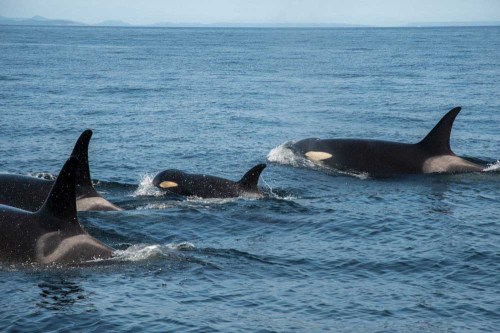Orca sightings along the Oregon Coast are up; so are their populations
Published 12:45 pm Tuesday, May 24, 2022

- More people are paying attention to orcas, like those seen here, swimming off the Oregon Coast. Scientists have enlisted the public's help in documenting orca activity to better understand the mammals.
If your social media feeds have suddenly lit up with images of orcas on the Oregon Coast, it’s not that the marine mammals have suddenly arrived, it’s that we’re suddenly paying closer attention.
Orcas, also known as killer whales, have long visited the shoreline of Oregon, mostly to feast on pinnipeds such as harbor seals and sea lions. But unlike watching the masses of migrating gray whales, spotting orcas is a lot harder, making their visits seem more rare.
Trending
Some researchers in the Pacific Northwest are hoping to change that by crowdsourcing videos and photos of orcas on the Oregon Coast, to get a better idea of the population sizes and behaviors of the apex predators.
Josh McInnes, a marine mammal scientist with the University of British Columbia, is one of the researchers behind a Facebook group called Oregon Coast Whale Watchers, a community that gathers documentation of marine mammals. Recently, the page has been filled with images of orcas, seen from Brookings to Newport and beyond.
McInnes said this month is a great time to look for orcas on the Oregon Coast, as they hunt for pinnipeds during pupping season from the end of March to the end of May. Sea lions and seals are surely aware of the orcas’ presence, but humans seem to be a little more ignorant, he said.
“Just because we don’t hear about sightings doesn’t mean the killer whales aren’t there,” McInnes said. “They rely on stealth to hunt, so they’re very quiet at the surface.”
Gray whales, which are much larger animals and are known for their distinctive spouts, curved backs and regular appearances at the surface of the water, are easier to spot. Orcas, which move much faster, are harder to spot — you may only see a tall, black fin sticking out of the water before the animal is gone.
Orcas, technically the world’s largest porpoise, are a complex species with many qualities that set them apart from other marine mammals on the Pacific Coast, making them one of the most fascinating animals to watch in the wild.
Trending
In the Pacific Northwest alone, there are several different subspecies of orcas that have different behaviors, eat different food and even speak different dialects. For example, the well-documented southern residents in the Salish Sea, between Washington state and Canada, eat only salmon and tend to stay in one location, while free-roaming transient orcas feast on mammals and have a much larger territory.
As the apex predators of the ocean, orcas are at the top of the food chain, and have been documented hunting everything from great white sharks to blue whales, which they often do in coordinated attacks.
On the Oregon Coast, there are typically two groups of transient orcas, McInnes said: the larger inner coast population that hunts along the shoreline, and the smaller outer coast population that swims in deeper waters. In all, researchers have documented about 349 inner coast and 180 outer coast orcas, he said.
In contrast to the southern residents, which also occasionally travel to the Oregon Coast, populations of transient orcas have been on the rise over the last three decades, in step with the rise in the pinniped population. Sea lions and seals were hunted extensively by humans in the 19th century, but have rebounded thanks to conservation efforts.
“It’s ecologically connected,” McInnes said. “You see an increase in the prey, you see an increase in predators; you see a decrease in prey, you see a decrease in predators.”
Bad news for pinnipeds, perhaps, but good news for orcas and those who are fortunate enough to see them in the wild.
Jim Burke, director of animal care at the Oregon Coast Aquarium, has lived on the coast for roughly 25 years and has had his share of orca sightings, both from land and in the water — an experience that always leaves him in awe.
“(It’s) the energy,” Burke said of seeing orcas. “They are extremely large, extremely powerful and in many ways smarter than us.”
He remembered feeling the hair stand up on the back of his neck as orcas approached while he was diving, and the sheer size and speed as they swam past. Even though the predators are no threat to humans in the wild, their size and power can be extremely intimidating.
Burke said the best places to look for orcas on the Oregon Coast are from the cliffs at the Sea Lion Caves, the Cape Perpetua viewpoint, the Yaquina Head Lighthouse and the rocky shoreline of Depoe Bay, as well as anywhere else you might find seals or sea lions in large numbers.
Spotting orcas can be made more difficult by nasty spring weather that often makes the ocean dark and choppy, he said, and requires a lot of luck. Orcas are not nearly as reliable as gray whales.
“It’s always awesome to come out to the coast because you never know what you’ll see,” Burke said, orcas included. “The only way you’re going to see them is if you’re out there looking.”
McInnes said he hopes more people will not only go out looking, but also document their sighting and share them with researchers. There’s still a lot to be learned about the orcas of the Oregon Coast, he said, and sightings from the general public go a long way in helping that work. He said people can send recent and historical sightings to his team at transientproject@gmail.com.
He attributes the increase in sightings this year to both the increase in transient orca populations and the increase in our own awareness of their presence. As pinniped and orca numbers rebound, we might be seeing something closer to what was a historical norm in Oregon.
“I think that this is something that’s probably occurred for a long time,” McInnes said. “This might just be what the normal was, and we didn’t realize it.”









